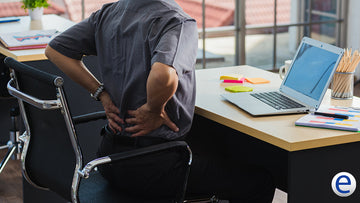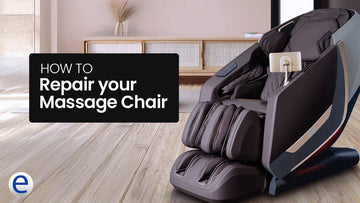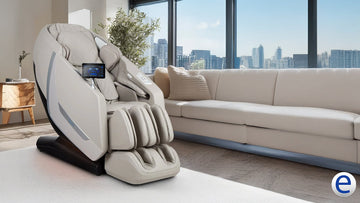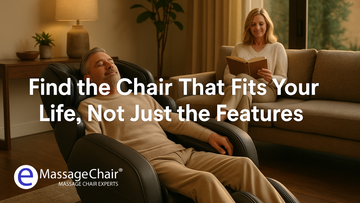I’ve been helping people choose the right massage chair for more than 15 years, and one of the most common questions I hear is: “Can a massage chair actually help my posture and recovery?” The short answer is yes — but only if you understand how they work and use them correctly.
Over the years, I’ve seen office workers stand taller, athletes recover faster, and older adults move with more ease — all from adding a consistent massage chair routine into their day. Here’s what I’ve learned.
Why Posture and Recovery Matter
Most of us spend hours sitting at desks, driving, or looking down at our phones. Poor posture isn’t just about slouching — it’s directly linked to back pain, neck strain, headaches, and even breathing issues (Harvard Health).
And when your recovery from workouts or daily stress takes too long, stiffness and fatigue can become constant companions.
Massage chairs don’t “fix” posture or magically heal injuries. What they do is relax tight muscles, improve circulation, and make it easier to maintain better alignment and recover faster.
First-Hand Experience: Who Benefits the Most
After working with thousands of customers, these are the three groups who see the biggest improvements:
- Desk workers: Relieve tight hip flexors and neck tension from sitting all day.
- Weekend athletes: Reduce soreness and boost recovery after training or long runs.
- Older adults: Improve mobility and confidence through daily low-intensity use and stretching.
The key is choosing the right chair and using it consistently.
How Massage Chairs Support Posture
Massage chairs help posture by targeting muscles and joints that pull your body out of alignment. Here’s how each feature plays a role:
- Track Designs (S, L, SL): S-Tracks follow your spine’s curve, while L and SL-Tracks extend into the glutes and hamstrings to aid pelvic balance. See our Track Comparison Guide.
- Roller Therapy: 3D and 4D rollers relax overactive muscles so you can reset into a neutral posture.
- Zero-Gravity Recline: Distributes your body weight evenly, reducing spinal compression.
- Heat Therapy: Increases circulation and loosens stiffness, especially in the lower back (Cleveland Clinic).
- Stretch Programs: Gentle traction and hip pulls release tightness and prepare you for posture exercises.
How Massage Chairs Aid Recovery
For recovery, massage chairs offer scientifically supported benefits:
- Relieving Soreness: Massage helps reduce delayed-onset muscle soreness (DOMS) and speeds strength recovery (PubMed).
- Boosting Circulation: Airbags and rollers mimic lymphatic drainage, improving oxygen and nutrient flow.
- Nervous System Reset: Sessions activate your parasympathetic nervous system — lowering stress and relaxing muscles (Mayo Clinic).
- Improving Flexibility: Regular use loosens fascia and joints, making stretching and movement easier.
Pros and Cons: The Balanced View
Pros:
- Convenient, at-home muscle therapy
- Complements posture training and exercise recovery
- Fully adjustable programs for different body types
Cons:
- Not a substitute for physical therapy or strength work
- Some chairs may not reach hamstrings or upper traps
- Overuse at high intensity can increase soreness
Who Benefits Most (and When to Be Careful)
Ideal Users:
- Office professionals and remote workers
- Athletes and fitness enthusiasts
- Seniors or parents managing back tension
Caution: Always consult your doctor if you’re pregnant, have clotting disorders, osteoporosis, or are recovering from surgery (NHS).
Choosing the Right Chair for Posture and Recovery
- Fit: Ensure it matches your height and covers glutes and hamstrings.
- Adjustability: Look for 3D/4D rollers and customizable intensity.
- Features: Seek stretch modes, lumbar heat, and recovery programs.
- Reliability: Prioritize strong warranties and long-term support.
👉 Explore our Buyer’s Guide or see our Top 10 Massage Chairs for expert recommendations.
Best Practices for Real Results
For Posture (Daily 15 Minutes):
- Start with lumbar heat → focus rollers on spine → finish with a stretch program → follow up with chin tucks or posture drills.
For Recovery (After Workouts):
- Use gentle-to-moderate pressure on legs and back.
- Avoid maximum intensity right after heavy training.
Pair your sessions with movement breaks and light strengthening for lasting improvements (Harvard Chan School).
Myths vs. Facts
-
Myth: Massage chairs fix posture on their own.
Fact: They relax tight muscles, allowing posture correction exercises to work better. -
Myth: Harder pressure speeds recovery.
Fact: Moderate, consistent sessions are most effective for lasting relief.
Conclusion
Massage chairs aren’t magic — but they’re one of the most effective, proven tools for improving posture and recovery when used consistently. Combine your chair sessions with stretching, posture drills, and regular movement, and you’ll see real results over time.
👉 Not sure which chair fits your goals? Fill out our Massage Chair Recommendation Form and get a personalized plan from an expert.




